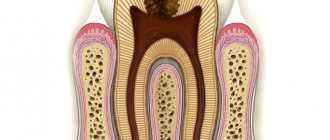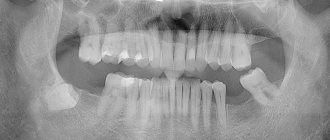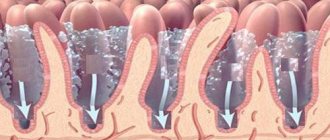A tooth abscess is an acute inflammation of its root, in which pus accumulates. This disease occurs quite often, is accompanied by severe pain and, if not treated in a timely manner, can lead to serious consequences. Let's look at the causes, symptoms and treatment methods for tooth abscess.
Causes and types of tooth abscess
There are many reasons for the development of the disease. The most common of them are the following conditions and diseases:
- advanced dental diseases such as periodontitis, gingivitis, pulpitis, granuloma, caries, dental cyst;
- damage to the mucous membranes of the oral cavity;
- mechanical tooth injuries;
- infection carried by the bloodstream during influenza, sore throat and other diseases;
- infection during dental procedures;
- boils on the skin in the jaw area;
- failure to comply with oral hygiene rules.
As a result of the above factors, tooth enamel is destroyed, which facilitates the easy penetration of pathogenic microorganisms into the dental pulp and the development of the inflammatory process.
At the German Dentistry Center, two types of dental abscess are distinguished. One of them is periapical, in which the infection spreads to the nerve endings and structures inside the tooth. With a periodontal abscess, an inflammatory process develops between the tooth and gum.
Content:
- What is a tooth abscess
- Classification of abscess in dentistry
- Causes of the disease
- Signs of illness
- Breakthrough of purulent masses with an abscess
- Treatment of the disease
- How to prevent a tooth abscess from occurring
A tooth abscess is an unpleasant and dangerous dental disease. It can occur in anyone. It is impossible not to notice its presence, since acute pain appears in the affected area and accumulations of pus form. Let's take a closer look at what this disease is, how to recognize it and treat it.
Cyst.
A dental cyst is perhaps the most common problem that brings people to the dentist for emergency treatment, as it can suddenly and unexpectedly cause severe pain and inflammation in the jaw area (abscess). With a superficial examination, it is almost impossible to detect a dental cyst. An X-ray or MRI may be needed to identify the cyst. Growth in the tooth area is easily noticeable. The cyst should be detected as early as possible so that it is easier for you to heal and without the risk of further damage to the tooth.
What is a tooth abscess
This is an infectious process caused by the accumulation of purulent masses in the outer or inner part of the alveolar process of the upper/lower jaw. Pathology develops due to the abnormal activity of pathogenic microorganisms that accumulate in the soft pulpal (often dead) part of the tooth.
A small bulge appears on the gum. It is painful to the touch and causes discomfort in a person. Gradually, pus begins to accumulate in the “bump.” The difficulty is that you cannot open it yourself, or even more so, squeeze it out - under the influence of external pressure, the necrotic masses will not only come out, but will also penetrate into the deeper layers of the gum. Then they can get into the blood and lymph - the infection will spread throughout the body.
Types and forms of abscess
Depending on where the pus accumulates, there are three types of pathology:
- gum abscess or gumboil affects only the gums;
- periodontal develops in the periodontal pocket;
- periapical appears with severe destruction of the pulp and other dental tissues.
This pathology often occurs in an acute form and requires immediate dental treatment. But sometimes the fistula opens on its own. The pus comes out and the patient feels relief. If complex therapy is not carried out, the pathology can become chronic.
Classification of abscess in dentistry
Doctors say there are three types of tooth abscess:
- Desnev. Only the soft tissues of the mouth are damaged. But, if the disease is started, the periodontal ligaments and periosteum will be drawn into the inflammatory process. Then flux develops.
- Periapical. The pulp is affected. If treatment is not carried out in a timely manner, you will have to perform depulpation or, even worse, tear out the affected unit. More often, this type of disease is diagnosed in children with primary occlusion, which is why dentists have to remove a preschooler’s incisors, canines and molars without waiting for their natural replacement by molars.
- Periodontal. The abscess has a destructive effect on the root, so the tooth becomes loose and falls out prematurely.
The main danger of a purulent tooth abscess is that the pus that has accumulated inside the tumor can penetrate into the blood. Then a general intoxication of the human body will occur. Internal organs, bones, and brain come under attack. A person who ignores the presence of an abscess may develop meningitis, sepsis, and even die.
What is a dental cyst?
A dental cyst is an abnormal cavity that contains fluid, cells and other organic substances and is surrounded by a strong wall. A dental cyst usually develops at the tip of a tooth, at the apex, due to inflammation of the nerve (Figure 1). In other cases, a cyst may appear around a tooth that has undergone root canal treatment but the bacteria have not been completely removed (Figure 2). The unfortunate thing is that over time, a dental cyst increases in size and can cause gradual destruction of the bone and adjacent teeth (Fig. 3) or affect more sensitive tissues such as the mandibular nerve (Fig. 4) (marked with a yellow line). This is the reason why a dental cyst should be removed as soon as possible.
Causes of the disease
Most often, abscesses are encountered by people who pay insufficient attention to oral health. Thus, untimely treatment of caries, pulpitis, gingivitis, granuloma, stomatitis, cysts can lead to the described disease. It has also been noted that the risk group for the development of pathology includes people with weakened immune systems, diabetics, cancer patients, people with HIV, obesity, and hormonal disorders.
An injury often leads to the accumulation of pus in the jaw. A less common reason is mistakes made by the dentist when treating tooth canals.
A gingival abscess is usually the result of traumatic injuries to the oral mucosa. It often appears a few days after a person burns himself while drinking a hot drink or scratches his gums with hard food.
Causes of development of purulent periodontal inflammation
Ignoring brushing and rinsing your teeth after eating only contributes to the development of pathological microflora, which subsequently leads to the appearance of periodontal disease, gingivitis, and periodontitis. Next, a gum pocket is formed, which is filled with pus and an abscess is formed.
Important!
By contacting the dentist at the first sign of gum disease (bleeding, redness, sensitivity) you will save time and money. By postponing a visit to the doctor, you are dooming yourself to unnecessary expenses and dooming your teeth to decay, which can be stopped with timely treatment.
In addition to poor hygiene, the development of periodontal abscess is facilitated by:
- mechanical periodontal injuries (a bone from a fruit or fish, a scratch with a fork);
- burn. We are not talking about “swallowing fire”; a hot drink is enough for an abscess to begin to develop on the weakened mucosal tissue;
- the habit of “grinding” your teeth, closing them tightly;
- crooked bite and deformed teeth.
To be fair, we note that 1% of the development of purulent inflammation of the subgingival pocket is the fault of unprofessional dentists. During mechanical cleaning or treatment of the tooth, the affected surface of the mucous membrane was not disinfected.
Signs of illness
It is almost impossible not to notice the presence of pathology - the symptoms are always very clear. Anyone, even those far from the medical field, can understand that something is wrong with their gums.
- First there is an acute toothache. It becomes more pronounced if you press on the unit, touch it, or knock on it. It intensifies if the patient drinks or eats something hot or cold.
- Soon the gums swell. Even the cheek may swell. This indicates that the inflammation is spreading quickly.
- A bulge forms on the gum. At first it is red or with a bluish tint. But it also happens that it is not there, and pus simply begins to ooze from the gums.
Due to the purulent masses, the patient has an unpleasant taste and a foul odor appears from the mouth. It is not possible to remove it using standard hygiene products - a toothbrush and toothpaste, since pus continues to actively form after brushing your teeth.
An advanced abscess contributes to an increase in body temperature, decreased appetite, and decreased performance. In many patients, the cervical lymph nodes become enlarged.
Symptoms of gum abscess
The main symptom of the disease is pain. It has a different character (aching, pulsating, acute), is constant or occurs periodically under the influence of stress factors (cold, heat, sour, sweet foods). The pain is often worse when chewing. It can be local or spread to neighboring teeth, ears, eyes. In addition, with an abscess there are other clinical manifestations:
- hyperemia of soft tissues around the affected segment;
- swelling of the inflammation zone;
- bitter taste in the mouth;
- foul odor;
- mobility and change in the natural color of the segment;
- the presence of an ulcer on the gum with purulent discharge;
- enlargement of the submandibular lymph nodes;
- facial deformation due to swelling;
- hyperthermia, lethargy, sleep disturbance.
Breakthrough of purulent masses with an abscess
Often the “bump” grows, swells, and then bursts. Then the pus inside it flows out. After this, the pain goes away and the patient’s well-being improves significantly. But this does not mean that the problem is a thing of the past. It should be remembered that with an abscess, fistula tracts often form. They serve as a protective reaction of the body - they ensure the unhindered outflow of pus and prevent the inflammatory process from further progressing.
The disease may recur. Purulent exudate is able to penetrate into the tissue surrounding the tooth. Therefore, even if the “bump” has burst, you still need to make an appointment with the dentist so that the doctor can conduct an examination and tell you what to do to prevent the disease from returning.
Diagnostics
To diagnose a tooth abscess, the dentist must conduct an examination of the oral cavity and take an x-ray of the tooth. An X-ray image reveals signs of an inflammatory process (widening of the periodontal fissure, thinning of the spongy substance of the alveolar process).
A visual examination reveals swollen, bright red areas of the gum mucosa and increased tooth mobility. With periodontal abscess, periodontal pockets up to 6 mm deep and higher, filled with purulent discharge and granulation tissue, are noticeable.
The purpose of diagnostic measures for a tooth abscess is to differentiate the pathology from an exacerbation of chronic periodontitis, cysts, periostitis, osteomyelitis.
Treatment of the disease
You should not try to cure a purulent “bump” on your own. Therapy should be carried out by an experienced dentist. First, the specialist carries out an examination and carries out the necessary diagnostic measures. Then he proceeds to opening the purulent formation. To do this, he uses a scalpel or laser beams. Since the drainage procedure is performed under local anesthesia, the patient does not feel pain.
The next step is to wash the wound and treat it with antiseptics, and apply antibacterial compounds. It also happens that drainage is installed in the affected area for several days to avoid re-accumulation of pus.
Afterwards, the tooth is treated or pulled out. In the first case, the nerve is removed. To do this, medicine is put into the unit and after a few days the dead nerve is removed. Afterwards, the canals are cleaned and sealed. Filling material or an individually made inlay is placed on top.
A tooth is pulled out only in advanced cases, when the roots have become unusable and cannot be treated. To prevent this, you need to see a doctor in a timely manner, and not hope that the disease will go away on its own.
If the patient complains of acute and pronounced pain, he is prescribed a painkiller. Most often these are tablets, but it is also possible to use a special anesthetic gel.
In order to achieve a guaranteed victory over inflammation and prevent recurrence of the abscess, the patient is also prescribed an antibiotic. The average course for the described diagnosis is from five to seven days. It is unacceptable to interrupt it in the middle because the condition has improved - the disease may return.
Local treatment, carried out at home after the dental surgeon has opened the abscess, consists of applying compresses with antibacterial compounds and performing therapeutic rinses. These procedures stimulate regeneration and accelerate tissue renewal.
Why self-medication is dangerous
Patients often resort to using traditional medicine while waiting to see a doctor. Such tactics most often only cause harm, because here you should act extremely carefully. If you suspect that you have flux, then do not perform the following manipulations:
- Applying bandages or warm compresses. This method increases the inflammatory process as the infection begins to spread faster.
- Take antibiotics at your own discretion. The use of such drugs must be carried out according to a certain scheme, because bacteria can adapt to the active substance, and the drug becomes ineffective over time. Therefore, medications should only be prescribed by a specialist.
- If you do not feel better 12 hours after the drainage procedure, you should not self-medicate. Contact a specialist immediately.
- Do not take analgesic medications 3-4 hours before your dentist appointment. This can make diagnosis difficult.
How to prevent a tooth abscess from occurring
To reduce the likelihood of developing a disease, you need to constantly follow these simple rules:
- brush your teeth two to three times a day;
- After each meal, rinse the mouth with warm water;
- use only high-quality hygiene products, carefully choose toothpaste, brushes, dental floss, irrigators, dental lotions and rinses;
- eat a balanced diet, eat as many fresh fruits and vegetables as possible, make sure that your diet includes solid foods that require thorough chewing;
- visit the dentist twice a year;
- undergo professional oral hygiene procedures annually;
- promptly treat all emerging diseases of the teeth and gums, prevent the progression of caries, pulpitis, and gingivitis.
It is also important to pay special attention to gum health. If they often become inflamed and bleed, perhaps the body lacks vitamins, minerals, or the tartar has become too large and is putting pressure on the delicate gum tissue. It is necessary to establish the cause of the problem and be sure to eliminate it.
People who take good care of the health of their teeth are much less likely to encounter an abscess and the complications caused by it. Therefore, do not forget the importance of maintaining oral hygiene.
The main reasons for the formation of flux
A certain number of factors lead to damage to the integrity of tooth enamel. Thus, the vital activity of bacteria moves to a new level, going deeper into the dental pulp, which becomes the cause of the development of the inflammatory process. Among these factors are:
- Injuries to the jaw or oral cavity resulting in a chip, crack, or fracture of a tooth.
- Problems or diseases of the oral mucosa or skin (including furunculosis on the jaw).
- Spread of infection through the bloodstream (in general infectious diseases).
- Advanced dental diseases: caries, periodontitis, pulpitis, cyst, etc.
- Infection during injections (for example, during preoperative pain relief).
The consequences of inaction in case of flux formation are very serious: inflammation can spread to periodontitis or even to the bone, which threatens the formation of oral phlegmon.









